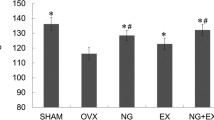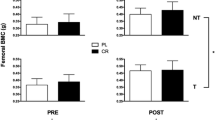Abstract
Osteocytes are recognized as having a pivotal role in bone tissue homeostasis, and stimuli that increase osteocyte death result in decreased bone tissue quality. Previous in vitro studies have shown that mechanical stimulation prevents osteocyte death; however, in vivo evidence of this protective effect is limited. The aim of this study was to investigate if mechanical stimulation provided by voluntary exercise reduces osteocyte death caused by estrogen deficiency. Thirty-two female Wistar rats (5 months old) were either sacrificed as baseline controls (BSL, n = 7), ovariectomized or sham-operated and housed in cages with a voluntary running wheel (OVXEX, n = 7; SHAMEX, n = 6), or ovariectomized or sham-operated and housed in standard cages of equivalent size (OVXSED, n = 6; SHAMSED, n = 6) and sacrificed at age 14 months. Histomorphometric analysis of femur mid-diaphysis cortical bone revealed a significantly higher osteocyte number (N.Ot) and lower empty lacunae number (N.Lc) in both the OVXEX and SHAMEX groups compared to their SED counterparts. Intracortical porosity (Po.Ar) was also lower in both EX groups compared to their SED counterparts and significantly correlated with N.Lc (r = 0.616; P < 0.001). Three-point bending testing showed a significantly higher Young’s modulus and ultimate stress in OVXEX compared to OVXSED and significant correlations between N.Lc and both yield stress (r = −0.376, P < 0.05) and ultimate stress (r = −0.369, P < 0.05) and between intracortical porosity and bone ultimate stress (r = −0.451, P < 0.05). Our results show that voluntary exercise prevented osteocyte death and that this protective effect was associated with increases in femur ultimate stress, which could be partially explained by decreases in Po.Ar.






Similar content being viewed by others
References
Civitelli R (2008) Cell–cell communication in the osteoblast/osteocyte lineage. Arch Biochem Biophys 473:188–192
Plotkin LI, Manolagas SC, Bellido T (2002) Transduction of cell survival signals by connexin-43 hemichannels. J Biol Chem 277:8648–8657
Ishihara Y, Kamioka H, Honjo T, Ueda H, Takano-Yamamoto T, Yamashiro T (2008) Hormonal, pH, and calcium regulation of connexin 43-mediated dye transfer in osteocytes in chick calvaria. J Bone Miner Res 23:350–360
Gramsch B, Gabriel HD, Wiemann M, Grummer R, Winterhager E, Bingmann D, Schirrmacher K (2001) Enhancement of connexin 43 expression increases proliferation and differentiation of an osteoblast-like cell line. Exp Cell Res 264:397–407
Chung DJ, Castro CH, Watkins M, Stains JP, Chung MY, Szejnfeld VL, Willecke K, Theis M, Civitelli R (2006) Low peak bone mass and attenuated anabolic response to parathyroid hormone in mice with an osteoblast-specific deletion of connexin43. J Cell Sci 119:4187–4198
Tan SD, Bakker AD, Semeins CM, Kuijpers-Jagtman AM, Klein-Nulend J (2008) Inhibition of osteocyte apoptosis by fluid flow is mediated by nitric oxide. Biochem Biophys Res Commun 369:1150–1154
Laketic-Ljubojevic I, Suva LJ, Maathuis FJ, Sanders D, Skerry TM (1999) Functional characterization of N-methyl-d-aspartic acid-gated channels in bone cells. Bone 25:631–637
Jiang JX, Cherian PP (2003) Hemichannels formed by connexin 43 play an important role in the release of prostaglandin E2 by osteocytes in response to mechanical strain. Cell Commun Adhes 10:259–264
Winkler DG, Sutherland MK, Geoghegan JC, Yu C, Hayes T, Skonier JE, Shpektor D, Jonas M, Kovacevich BR, Staehling-Hampton K, Appleby M, Brunkow ME, Latham JA (2003) Osteocyte control of bone formation via sclerostin, a novel BMP antagonist. EMBO J 22:6267–6276
Lin C, Jiang X, Dai Z, Guo X, Weng T, Wang J, Li Y, Feng G, Gao X, He L (2009) Sclerostin mediates bone response to mechanical unloading through antagonizing Wnt/beta-catenin signaling. J Bone Miner Res 24:1651–1661
Manolagas SC, Parfitt AM (2010) What old means to bone. Trends Endocrinol Metab 21:369–374
Kousteni S, Bellido T, Plotkin LI, O’Brien CA, Bodenner DL, Han L, Han K, DiGregorio GB, Katzenellenbogen JA, Katzenellenbogen BS, Roberson PK, Weinstein RS, Jilka RL, Manolagas SC (2001) Nongenotropic, sex-nonspecific signaling through the estrogen or androgen receptors: dissociation from transcriptional activity. Cell 104:719–730
Tomkinson A, Gevers EF, Wit JM, Reeve J, Noble BS (1998) The role of estrogen in the control of rat osteocyte apoptosis. J Bone Miner Res 13:1243–1250
Tomkinson A, Reeve J, Shaw RW, Noble BS (1997) The death of osteocytes via apoptosis accompanies estrogen withdrawal in human bone. J Clin Endocrinol Metab 82:3128–3135
Emerton KB, Hu B, Woo AA, Sinofsky A, Hernandez C, Majeska RJ, Jepsen KJ, Schaffler MB (2009) Osteocyte apoptosis and control of bone resorption following ovariectomy in mice. Bone 46:577–583
Mann V, Huber C, Kogianni G, Collins F, Noble B (2007) The antioxidant effect of estrogen and selective estrogen receptor modulators in the inhibition of osteocyte apoptosis in vitro. Bone 40:674–684
Qiu S, Rao DS, Palnitkar S, Parfitt AM (2003) Reduced iliac cancellous osteocyte density in patients with osteoporotic vertebral fracture. J Bone Miner Res 18:1657–1663
Tatsumi S, Ishii K, Amizuka N, Li M, Kobayashi T, Kohno K, Ito M, Takeshita S, Ikeda K (2007) Targeted ablation of osteocytes induces osteoporosis with defective mechanotransduction. Cell Metab 5:464–475
Cardoso L, Herman BC, Verborgt O, Laudier D, Majeska RJ, Schaffler MB (2009) Osteocyte apoptosis controls activation of intracortical resorption in response to bone fatigue. J Bone Miner Res 24:597–605
Qiu S, Rao DS, Palnitkar S, Parfitt AM (2002) Relationships between osteocyte density and bone formation rate in human cancellous bone. Bone 31:709–711
Weinstein RS, Wan C, Liu Q, Wang Y, Almeida M, O’Brien CA, Thostenson J, Roberson PK, Boskey AL, Clemens TL, Manolagas SC (2009) Endogenous glucocorticoids decrease skeletal angiogenesis, vascularity, hydration, and strength in aged mice. Aging Cell 9:147–161
Plotkin LI, Mathov I, Aguirre JI, Parfitt AM, Manolagas SC, Bellido T (2005) Mechanical stimulation prevents osteocyte apoptosis: requirement of integrins, Src kinases, and ERKs. Am J Physiol Cell Physiol 289:C633–C643
Aguirre JI, Plotkin LI, Stewart SA, Weinstein RS, Parfitt AM, Manolagas SC, Bellido T (2006) Osteocyte apoptosis is induced by weightlessness in mice and precedes osteoclast recruitment and bone loss. J Bone Miner Res 21:605–615
Bakker A, Klein-Nulend J, Burger E (2004) Shear stress inhibits while disuse promotes osteocyte apoptosis. Biochem Biophys Res Commun 320:1163–1168
Olson ME, Bruce J (1986) Ovariectomy, ovariohysterectomy and orchidectomy in rodents and rabbits. Can Vet J 27:523–527
Fazzalari NL, Parkinson IH, Fogg QA, Sutton-Smith P (2006) Antero–postero differences in cortical thickness and cortical porosity of T12 to L5 vertebral bodies. Joint Bone Spine 73:293–297
Turner CH, Burr DB (1993) Basic biomechanical measurements of bone: a tutorial. Bone 14:595–608
Coleman MA, Garland T Jr, Marler CA, Newton SS, Swallow JG, Carter PA (1998) Glucocorticoid response to forced exercise in laboratory house mice (Mus domesticus). Physiol Behav 63:279–285
Burr DB (1997) Muscle strength, bone mass, and age-related bone loss. J Bone Miner Res 12:1547–1551
Luu YK, Capilla E, Rosen CJ, Gilsanz V, Pessin JE, Judex S, Rubin CT (2009) Mechanical stimulation of mesenchymal stem cell proliferation and differentiation promotes osteogenesis while preventing dietary-induced obesity. J Bone Miner Res 24:50–61
Pavalko FM, Gerard RL, Ponik SM, Gallagher PJ, Jin Y, Norvell SM (2003) Fluid shear stress inhibits TNF-alpha-induced apoptosis in osteoblasts: a role for fluid shear stress-induced activation of PI3-kinase and inhibition of caspase-3. J Cell Physiol 194:194–205
Cerri PS, Boabaid F, Katchburian E (2003) Combined TUNEL and TRAP methods suggest that apoptotic bone cells are inside vacuoles of alveolar bone osteoclasts in young rats. J Periodontal Res 38:223–226
Parfitt AM (2002) Life history of osteocytes: relationship to bone age, bone remodeling, and bone fragility. J Musculoskelet Neuronal Interact 2:499–500
Frost HM (1960) In vivo osteocyte death. J Bone Joint Surg Am 42:138–143
Qiu S, Rao DS, Palnitkar S, Parfitt AM (2002) Age and distance from the surface but not menopause reduce osteocyte density in human cancellous bone. Bone 31:313–318
Qiu S, Rao DS, Fyhrie DP, Palnitkar S, Parfitt AM (2005) The morphological association between microcracks and osteocyte lacunae in human cortical bone. Bone 37:10–15
Weinstein RS (2010) Glucocorticoids, osteocytes, and skeletal fragility: the role of bone vascularity. Bone 46:564–570
Sauren YM, Mieremet RH, Groot CG, Scherft JP (1992) An electron microscopic study on the presence of proteoglycans in the mineralized matrix of rat and human compact lamellar bone. Anat Rec 232:36–44
Liebschner MA, Keller TS (2005) Hydraulic strengthening affects the stiffness and strength of cortical bone. Ann Biomed Eng 33:26–38
Nyman JS, Roy A, Shen X, Acuna RL, Tyler JH, Wang X (2006) The influence of water removal on the strength and toughness of cortical bone. J Biomech 39:931–938
Dong XN, Guo XE (2004) The dependence of transversely isotropic elasticity of human femoral cortical bone on porosity. J Biomech 37:1281–1287
Burghardt AJ, Kazakia GJ, Ramachandran S, Link TM, Majumdar S (2010) Age- and gender-related differences in the geometric properties and biomechanical significance of intracortical porosity in the distal radius and tibia. J Bone Miner Res 25:983–993
Chavassieux P, Seeman E, Delmas PD (2007) Insights into material and structural basis of bone fragility from diseases associated with fractures: how determinants of the biomechanical properties of bone are compromised by disease. Endocr Rev 28:151–164
Bagi CM, Ammann P, Rizzoli R, Miller SC (1997) Effect of estrogen deficiency on cancellous and cortical bone structure and strength of the femoral neck in rats. Calcif Tissue Int 61:336–344
Ouyang H, Sherman PJ, Paschalis EP, Boskey AL, Mendelsohn R (2004) Fourier transform infrared microscopic imaging: effects of estrogen and estrogen deficiency on fracture healing in rat femora. Appl Spectrosc 58:1–9
Russo CR, Lauretani F, Seeman E, Bartali B, Bandinelli S, Di Iorio A, Guralnik J, Ferrucci L (2006) Structural adaptations to bone loss in aging men and women. Bone 38:112–118
Seeman E (2003) Periosteal bone formation—a neglected determinant of bone strength. N Engl J Med 349:320–323
Orwoll ES (2003) Toward an expanded understanding of the role of the periosteum in skeletal health. J Bone Miner Res 18:949–954
Acknowledgments
The authors express their gratitude to Celeste Resende for her skilled technical involvement. The present work was supported by Fundação para a Ciência e Tecnologia (FCT) grant PTDC/DES/103047/2008. H. F. and D. M.-G. are supported by FCT fellows SFRH/BD/38110/2007 and SFRH/BD/33123/2007, respectively.
Author information
Authors and Affiliations
Corresponding author
Additional information
The authors have stated that they have no conflict of interest.
Rights and permissions
About this article
Cite this article
Fonseca, H., Moreira-Gonçalves, D., Esteves, J.L.S. et al. Voluntary Exercise has Long-Term In Vivo Protective Effects on Osteocyte Viability and Bone Strength Following Ovariectomy. Calcif Tissue Int 88, 443–454 (2011). https://doi.org/10.1007/s00223-011-9476-2
Received:
Accepted:
Published:
Issue Date:
DOI: https://doi.org/10.1007/s00223-011-9476-2




